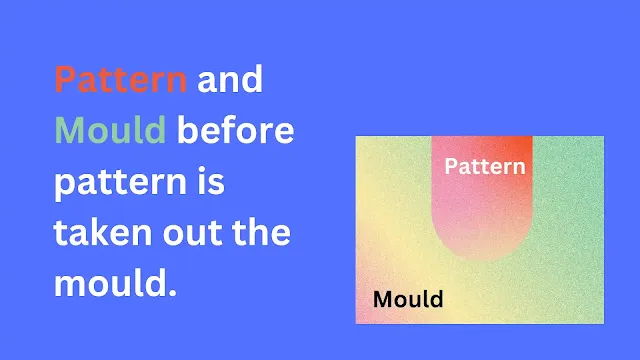Rapping Allowance or Shake Allowance In Casting

|
| Rapping Allowance In Casting |
Shake Allowance
What is the rapping allowance or shake allowance in casting?
The process of pattern removal from the mould starts with striking the pattern with a wooden piece or vibrating the pattern. This step is done to loosen the pattern wrapped around all sides with mould.
Striking the pattern with a striking bar loosens the pattern from the mould to create a small void or gap for easy pattern withdrawal.
Once the moulding sand is separated from the pattern, the pattern is removed from the mould with the help of the draw spike.
While the pattern is been removed from the mould cavity, the pattern shakes in the mould and creates an enlarged mould cavity. If the same mould cavity is used to make casting the final casting will be oversized than the required desirable casting.
Rapping allowance or shake allowance can be defined as allowance given to a pattern to reduce the size of the pattern to compensate for the change in the dimension of the mould cavity while the pattern is withdrawn or shakeout from the mould during the mould-making process.
Shake allowance is added to the pattern to avoid damage and enlarged mould size while the pattern is withdrawn from the mould during the mould-making process.
To solve this problem of the final casting being oversized, the pattern is made smaller or undersized than the original casting keeping in mind an increase in the dimension of mould during pattern withdrawal or shake out.
A negative allowance is given on the pattern to take care of the rapping allowance or shake allowance.
Rapping allowances are neglected or ignored for small-size casting.
Rapping or shaking allowance is one of the allowances among the 6 types of allowance in casting.
As shown below in diagram (a) sand is rammed and the pattern sits in the mould to create a mould cavity. This pattern remains in the mould during the ramming process until taken out from the mould.

|
| (a) Mould Before Pattern Is Taken Out |
Now while removing the pattern, the pattern shakes or moves to add an extra unnecessary dimension increasing the size of the mould cavity as shown below in diagram (b).

|
| (b) Enlarged Mould While Pattern Been Withdrawn From Mould |
This shaking of the pattern causes the size of the mould cavity to increase causing the final casting to be oversized as shown in the diagram below (c). This oversized casting will need extra unnecessary machining to pass the quality and dimensional accuracy test.

|
| (c) Oversize Casting Without Shake Allowance |
In order to compensate for an increase in the size of the mould cavity a pattern is made of a smaller size than the actual final casting.
As shown below in diagram (d) oversized casting with and without shake/rapping allowance. Pattern without allowance will create casting which is oversized as compared to the pattern which is undersized will create desired size casting.

|
|
(d) Oversized Casting Vs Required Casting |
Why is shake allowance negative allowance?

|
| (e) Shake Allowance In Casting |
Rapping allowance is a negative allowance because the pattern is made smaller in size as compared to the actual final casting.
Shake allowance is only applied to dimensions that are parallel to the parting line.
Due to the allowance pattern being made smaller than the required size taking into consideration the change in the size of the mould while taking the pattern out.
Shaking allowance is negative allowance and the pattern is made smaller in size than the original dimensions of casting on the drawing.
Rapping allowance is provided on the pattern to take care of easy withdrawal of the pattern from the mould cavity.
If the allowance is not given to the pattern final casting will be oversized shown above in diagram (d).
Why pattern need to be shaken, strike and vibrated to take it out of the mould cavity?
The pattern is always surrounded by the moulding sand or backing sand in the mould.
It becomes necessary to separate the pattern and the moulding sand.
To separate the pattern and the mould the pattern needs to be shaken, struck with a wooden piece or vibrated as the pattern clings to the moulding sand because of adhesiveness property.
Is shake allowance a negative allowance? Explain why?
Yes, the shake allowance is a negative allowance because the pattern is made smaller in size to compensate for the increase in the size of the mould cavity while the pattern is withdrawn from the mould cavity.
Does shake allowance depend upon the shape, size and complexity of the casting?
Yes, allowance for casting depends on the size, shape and complexity of the casting to be produced.
For smaller casting allowance is not required as the pattern which is a replica of the casting can be easily withdrawn from the mould cavity.
But for larger and more complex patterns allowance is provided considering the pattern removal process from the mould will be a lengthy process plus chances of mould damage and mould enlargement will be high.
One way to reduce the shake or rapping allowance is to increase the draft allowance.
Is the pattern made larger or smaller in shake allowance?
Shake allowance is negative allowance and the pattern is made smaller than the original casting to compensate for the change in the dimension of the mould while a pattern is been withdrawn from the mould cavity.
The size of the mould increases because of shaking the pattern to separate moulding sand from the pattern increasing the size of the mould. To solve this problem pattern is made smaller in size.
At what surface of the pattern shake or rapping allowance are provided?
The pattern in the mould cavity is surrounded by sand, but while the pattern is shaken out vertical faces of the pattern tend to get damaged and change in its dimensions.
Thus, shake or rapping allowance is provided on the vertical faces of the pattern and parallel to the parting plane.
Rapping Allowance Advantage
What are the advantages of rapping allowance in casting?
- This allowance improves the dimensional accuracy of the final casting.
- Saves on resources such as molten metal, energy and time of the foundry as final casting is less rejected.
- Reduces machining cost, labour cost and time associated with oversized casting.
- After providing allowance pattern can be removed with confidence from the mould cavity.
- Allowance is provided on the pattern to take care of easy withdrawal of pattern from the mould without making the mould cavity larger than the original casting.
Rapping Allowance Factors Consideration
What are the factors to consider while giving a rapping allowance to the pattern?
Rapping allowance depends upon the following factors:
- Size of the mould, A larger mould requires more pattern allowance.
- Size, shape and complexity of the pattern, the larger pattern requires more allowance.
- Pattern removal skill and experience of the operator.
- Type of sand used in the mould.
- Pattern removal technique for high-weight pattern material.
- Expected dimensional accuracy of the casting.
- Amount of sand ramming done during machine or hand moulding process.
- Draft or taper allowance provided on the pattern.
- Pattern material and expected dimensional requirement of the pattern.
- Green strength and hardness property of the moulding sand while pattern withdrawing process.
Shake Allowance Calculation
What calculation and formula is used to calculate shake or rapping allowance in casting?
There is no exact formula to calculate the rapping allowance in casting.
Rapping allowance depends on trial and error and previous experience of the mould and pattern maker.
The larger the pattern to be removed from the mould larger the rapping allowance. Rapping allowance is normally 1-2mm for large-size casting but mostly depends on the mould and pattern maker in the foundry.
At times rapping allowance can be clubbed with machining allowance for medium-size casting but is not possible for bigger casting.
Rapping Allowance Conclusion
Rapping allowance or shake allowance is applied to the pattern by making the pattern smaller in size to take care of the enlarged mould cavity during pattern withdrawal.
This is a negative allowance as the pattern is made smaller in size as compared to the original casting size.
This allowance improves dimensional accuracy and reduces the rejection of the final sand casting in the foundry by making a casting of the exact size desired.
What is the difference between a rapping allowance and a draft allowance?
| Rapping or Shake Allowance In Casting | Draft Allowance |
|---|---|
| 1) Allowance is provided to eliminate mould getting oversized as the pattern shakes during withdrawal. | 1) Allowance is provided for easy withdrawal of the pattern without damaging the mould surfaces. |
| 2) This is a negative allowance. | 2) This is a positive allowance. |
| 3) Reduces oversizing of the final casting. | 3) Improves pattern withdrawal without damaging the vertical surface of the wall. |
| 4) The pattern is made smaller. | 4) Extra metal is added to the pattern to make the pattern tapered. |
| 5) Allowance can be reduced with some draft or taper angle on it. | 5) Rapping allowance cannot reduce draft allowance. |
